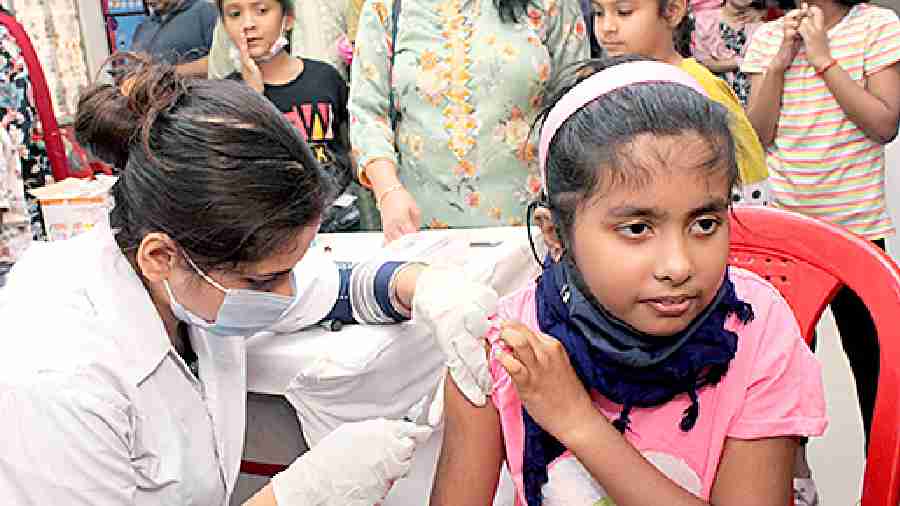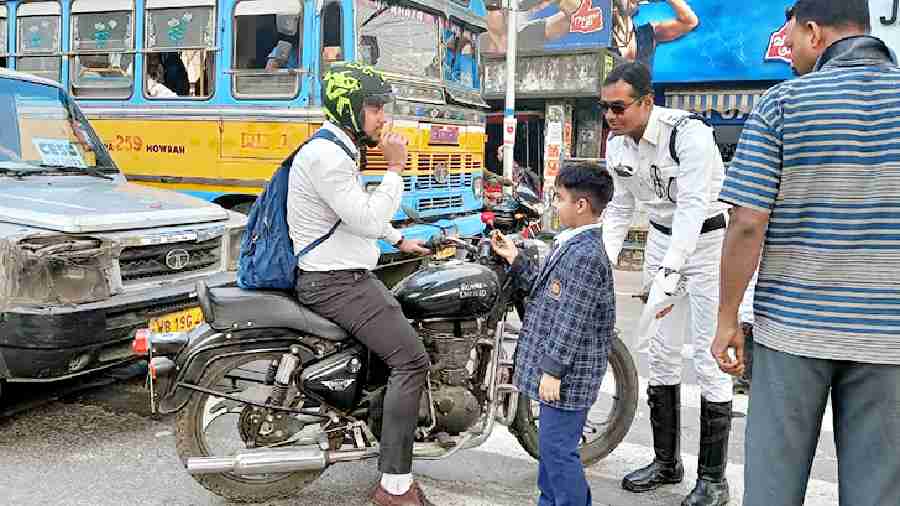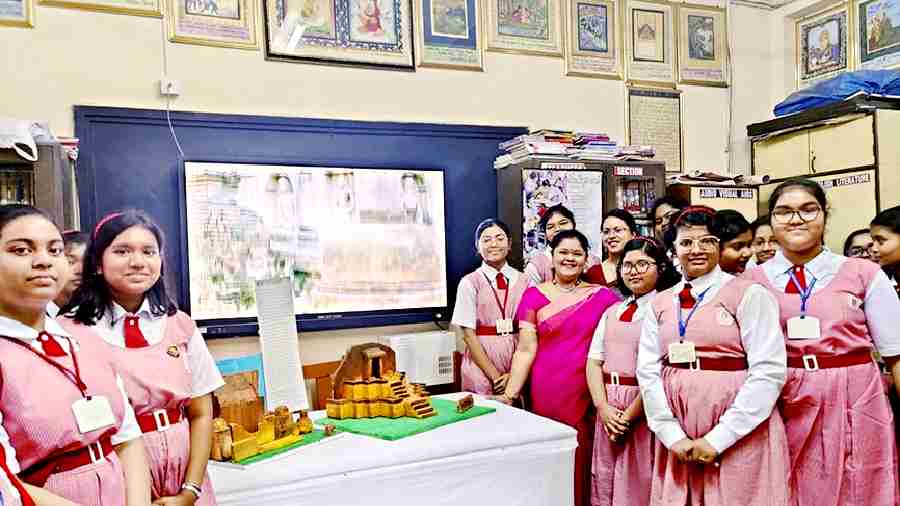The Bhawanipur Gujarati Education Society School
Students of The Bhawanipur Gujarati Education Society School (The BGES School) got to play with some pet animals in between classes. To build empathy and love for animals among children, the school organised a pet show on January 16, 18 and 19 in association with Cape Foundation.
It was a fun time for the students as two dogs, two rabbits, one kitten, one guinea pig, two ducks, one hen, one rooster, one goat and one cat were brought to the school by Radhika Bose and Sanjay Sen of the foundation.
They instilled in the kids the importance of co-existence. The children were taught how animals need tenderness, care and unconditional love, just like humans. The students were also educated about animals’ laws and their right to be treated with dignity.
The children petted the animals and tried to interact with them.
Principal Brij Bhushan Singh said: “Interactive learning is the best way to make kids understand new concepts. Teachers have unique ways to help students learn, from fun activities to quizzes. This year, bringing pets into the school and allowing children to play with them not only made the little ones happy but also emotionally sensitive. The children had an amazing time, and the show was loved by all.”
Contai Public School

Students of Contai Public School took part in a nature trail to develop greater awareness and empathy towards the greenery around and work for the planet’s sustainable development.
A group of 45 students of Class IX, along with four teachers, took part in a daylong biodiversity camp last year. The event was organised by the West Bengal Biodiversity Board in association with the Digha Science Centre and National Science Camp, Medinipur.
Principal Samarendranath Das kickstarted the event by defining biodiversity and explaining to the students why it is necessary to maintain it.
The science teachers organised an open discussion where the students were invited to express their views on issues. Many students shared their ideas on how they can contribute to keeping the local flora and fauna safe.
Many other related issues were discussed such as water and biodiversity-related threats, the impact of climate change, conservation needs and efforts made at the regional, national and international levels.
After registration, the entire team, along with experts, headed towards Oceana resort in New Digha from where the nature trail began.
Students were introduced to various flora and fauna and educated about their scientific names. They learnt about native and invasive species and also the art of nature interpretation.
The second part of the camp included a visit to a neighbouring area that had witnessed a recent mangrove plantation. Students got a chance to correlate with their bookish knowledge of pneumatophores.
Post lunch, the group watched a science show and was part of an interactive session.
“The activities at the camp and the nature trail that we took part in were designed to instil in students a personal relationship and responsibility towards nature,” said the principal.
The school’s joint head of the department of science Avishek Dasgupta said: “The entire schedule was made in such a way that children get an opportunity to explore nature through interesting activities such as nature walk and learn the importance of biodiversity.
Sushila Birla Girls’ School

Sushila Birla Girls’ School organised a vaccination drive against rubella and measles for students from Nursery to Class X on January 28. More than 600 students got vaccinated at the camp.
The state department of health and family welfare had instructed all educational institutions to organise vaccination camps in schools for the prevention of measles and rubella. The decision was taken given the rise in measles cases among children even at the age of 15.
“We are thankful to the government for organising this campaign. We were happywith the turnout,” said headmistress Vidisha Panja.
Ruby Park Public School

Students of Classes IV and V of Ruby Park Public School took part in a road safety awareness campaign in association with Kolkata Police recently. As part of the campaign themed, Safe Drive Save Life, the students shared tips on safety while driving or walking with commuters at Taratala crossing. Classes III, IV and V also prepared posters to spread the word around.
The students, assisted by the cops, gave roses and chocolates to the traffic rule violators while explaining to them the dangers of flouting such basic rules. It was their way of explaining with love and showing concern.
The event also made the children aware of the safety measures to be taken on road as they spread caution.
“Safety is the best policy. The students of Ruby Park Public School celebrated traffic safety week on February 9 at Taratala crossing, where they spread awareness about precautionary measures that can be used to prevent road accidents,” said principal Joyeeta Majumdar.
Bidya Bharati Girls’ High School

A platform to showcase one’s creative talents — that’s what Melange, an exhibition organised by Bidya Bharati Girls’ High School — was about. The event was organised on February 10 and 11. Classrooms showcased projects and models on various topics, highlighting the hard work that went behind the event.
The students of Classes V to XI had prepared their displays for over a month on every subject from physics to yoga. There were cultural events too.
As one entered the school hall, yoga moves by students greeted the eye. In the sports section, there were chess, carrom and table tennis arranged for teachers, students or visitors to take a break and play.
The cultural performances took place on the floor above. There were dance performances. Works of young artists — sketches, mandala art and portraits — were on display here.
The geography department students showcased models on the course of a river, pond ecosystem, renewable and non-renewable energy sources, tundra climate, working principle of a windmill, volcanic eruptions and other issues. They explained the Aurora Borealis and some wonders of nature to the visitors.
Participants from the history section spoke about the Pala and Sena dynasties to the visitors. On display were models and some paintings showcasing Buddhist monks of the Pala and Sena periods.
The students of political science highlighted the importance of fundamental rights and duties, while the students from nutrition spoke about the food pyramid and the nutritious value of a common breakfast and lunch. Students of home management showcased the process of tie-and-dye bandhani.
Members of the interact club demonstrated a few techniques of self-defence.
The Class XI students from commerce created interesting charts on cyber caution and modern-day banking.
Economics students showcased the economic development of Darjeeling. The maths students demonstrated topics such as symmetry and congruency, while statistics students demonstrated the Covid death rate by bar diagram.
Computer and robotics students showcased the working principle of a burglar alarm. Chemistry students performed many interesting experiments. The biology students ran an awareness campaign about thalassemia.
Physics students demonstrated holograms, reflection of sound waves and drones.
Psychology students of Class XI gave a PowerPoint presentation and live performances on music therapy. In English, students made models from Shakespearean plays such as Romeo and Juliet and The Tempest.
In Bengali, the students performed poems and skits on works of authors such as Sukumar Ray, Manoj Mitra and many others. In Hindi, there were models on Bhaktikaal, Meera, Surdas and Tulsidas.
“This is an academic exhibition where the students are getting to learn in depth the subjects they have taken up,” said headmistress Sharmistha Banerjee.
